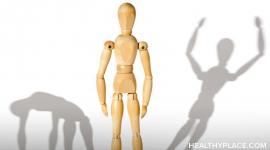What Is Bipolar I Disorder? Definitions, Symptoms, Treatment

Bipolar I disorder (also known as bipolar disorder type I and once known as manic depression) is a serious mental illness that affects hundreds-of-thousands of Americans every year. Bipolar I disorder (sometimes spelled bipolar disorder type 1) affects approximately one percent of the population over the course of their lifetime in the United States. This equals three million people in the United States. To put that in perspective, that’s slightly less than the risk of a woman developing bladder cancer in her lifetime or approximately equal to the risk of a man developing stomach cancer in his lifetime.
This type of bipolar disorder is often thought of as “classic” bipolar disorder as its symptoms were the first diagnostically recognized and it’s the kind most frequently portrayed in the media. Bipolar disorder type I is characterized by periods of a highly elevated or irritable mood known as mania alternating with periods of deep, profound depression. People with bipolar disorder type I can also experience periods without mood symptoms or with few mood symptoms. These are known as euthymic periods or euthymia.
Bipolar I Disorder Definition and DSM-5 Criteria
To be diagnosed with bipolar disorder type I, the person must have experienced at least one period of mania and at least one period of depression as defined in the Diagnostic and Statistical Manual of Mental Disorders, Fifth Edition (DSM-5).
According to Medscape, the DSM-5 defines manic episodes as at least one week, consecutively, of profound mood disturbance, characterized by elation, irritability, or expansiveness. (These are referred to as gateway criteria.) At least three of the following symptoms must also be present:
- Grandiosity (an exaggerated belief in one’s importance, sometimes reaching delusional proportions; delusions are false beliefs held in spite of confrontation with contrary facts)
- Diminished need for sleep
- Excessive talking or pressured speech
- Racing thoughts or flight of ideas
- Clear evidence of distractibility
- Increased level of goal-focused activity at home, at work or sexually
- Excessive pleasurable activities, often with painful consequences
The mood disturbance must be sufficient to cause impairment at work or danger to the individual or others. The mood must not be the result of substance abuse or a medical condition.
According to Medscape, the DSM-5 defines depressive episodes (depressions; major depressions) as, for the same two weeks, experiencing five or more of the following symptoms, with at least one of the symptoms being either a depressed mood or characterized by a loss of pleasure or interest:
- Depressed mood
- Markedly diminished pleasure or interest in nearly all activities (also known as anhedonia)
- Significant weight loss or gain or significant loss or increase in appetite
- Hypersomnia or insomnia (too much or too little sleep)
- Psychomotor retardation or agitation (physical and psychological slowing or restlessness)
- Loss of energy or fatigue
- Feelings of worthlessness or excessive guilt
- Decreased concentration ability or marked indecisiveness
- Preoccupation with death or suicide; patient has a plan or has attempted suicide
These symptoms must cause significant impairment and distress and must not be the result of substance abuse or a medical condition.
DSM-5 Bipolar Disorder Type I Specifiers
While manias and depressions are the two required moods for a bipolar disorder type I diagnosis, either mood can actually have additional common features and thus, can be further defined by a specifier. Specifiers can be used with either mood type. So, for example, a person could experience a mania with psychotic features or depression with psychotic features.
Specifiers that can be used are:
- With mixed features – when the diagnosed mood (either depression or mania) presents with symptoms of its opposite mood (this is often just termed a “mixed mood”)
- With anxious distress – when the mood episode occurs with symptoms of anxiety
- With rapid cycling – when four or more distinct mood episodes (of any type) occur within one year
- With psychotic features – when the mood episode occurs with the symptoms of psychosis (the presence of delusions and/or hallucinations; hallucinations are false experiences involving any sense)
- With catatonia – when the mood episode occurs with a syndrome characterized by muscular rigidity and mental stupor, sometimes alternating with great excitement and confusion
- Peripartum onset (also known as postpartum onset) – when the mood episode occurs during pregnancy up to four weeks after delivery
- Seasonal pattern – when the onset and remission of major depressive episodes are at specific times of the year
- With atypical features – when the depression occurs with a specific combination of features such as oversleeping, a heavy feeling in the arms or legs and mood that improves in reaction to positive events
- With melancholic features – when the depression occurs with specific depression features such as a lack a reactivity to positive events, significant anorexia or weight loss or depression that’s regularly worse in the morning
Bipolar Disorder Type I Treatment
Bipolar disorder type I treatment typically starts with a thorough evaluation so as to decide on next steps. The most important part of the assessment is to determine whether the person is a danger to themselves or others or is unstable. Examples of this would be if the person is suicidal, homicidal or psychotic. If a person has a dangerous condition or is unstable, the person will typically require inpatient treatment in a psychiatric hospital. In the case where a person is experiencing bipolar symptoms but has a stable home life, that person may be a candidate for day treatment or partial hospitalization where the person lives at home but receives treatment for multiple hours each day. In most other cases, bipolar disorder type I can be treated in an outpatient setting.
Treatments generally used in bipolar disorder type I include:
- Medication therapy
- Psychotherapy
- Electroconvulsive therapy (ECT)
- Lifestyle changes
Medication used in the treatment of bipolar disorder type I depends on the type of episode the person is having. For example, in an acute manic episode, a doctor might choose from an antipsychotic medication, a benzodiazepine or an anticonvulsant. (Note that benzodiazepines are not Food and Drug Administration (FDA) approved for use in bipolar mania but a doctor may prescribe them if needed.)
The following is a list of FDA-approved medications for use in bipolar disorder and the episode type for which they are approved (brand names in brackets):
- Aripiprazole (Abilify) – For use in mania, mixed episodes and bipolar maintenance.
- Asenapine (Saphris) – For used in mania and mixed episodes.
- Carbamazepine Extended Release (Equetro) – For use in mania and mixed episodes.
- Cariprazine (Vraylar) – For use in mania and mixed episodes.
- Chlorpromazine (Thorazine) – For use in mania.
- Lamotrigine (Lamictal) – For use in bipolar maintenance.
- Lithium – For use in mania and bipolar maintenance.
- Lurasidone (Latuda) – For use in depression.
- Olanzapine (Zyprexa) – For use in mania, mixed episodes and bipolar maintenance.
- Olanzapine/fluoxetine combination (Symbyax) – For use in depression.
- Quetiapine (Seroquel) – For use in mania and depression.
- Risperidone (Risperdal) – For use in mania and mixed episodes.
- Divalproex sodium (Depakote) – For use in mania.
- Ziprasidone (Geodon) – For use in mania and mixed episodes.
While the above medications are approved by the FDA for the given circumstances, it is common for people with bipolar disorder type I to need multiple medications to remain stable. Additional, unlisted medications may also be of use at the doctor’s discretion ("List of Bipolar Depression Medications and Their Side-Effects").
There are several types of psychotherapy that have been proven to be useful when treating bipolar disorder type I. They include:
- Prodrome detection therapy – includes education about the early warning signs of a bipolar mood episode and what to do about them
- Psychoeducation – includes learning about mental illness and bipolar, specifically
- Cognitive therapy – includes several components including identifying dysfunctional beliefs and medication adherence
- Interpersonal/social rhythm therapy – includes understanding the importance of routine in daily life
- Family-focused therapy – includes components of the above therapies but involves all members of the family as well
Electroconvulsive therapy (ECT) can also be used to treat bipolar disorder type I. Electroconvulsive therapy involves running a current of electricity through the brain, causing a seizure, while the person is under general anesthesia. This treatment type has been shown to be highly effective in treating acute mania.
The following situations are ones in which ECT treatment for bipolar disorder type I might be chosen:
- When rapid treatment is required due to the immediate dangers posed by the illness
- When the risks of ECT are less than that of other treatments
- When other treatments have been tried and have failed
- When the person with bipolar disorder chooses this treatment type
Lifestyle changes are generally part of the treatment of bipolar disorder type I. Some of these changes are covered through therapies like psychoeducation and interpersonal/social rhythm therapy. These lifestyle changes might include:
- Adding an omega-3 supplement to the diet – this has been shown to help with bipolar depression symptoms
- Exercising
- Creating a daily routine, particularly in regards to waking up and going to bed at the same time every day
- Ceasing all alcohol and drug use
Bipolar Disorder Type I Prognosis
Bipolar I disorder is a highly persistent illness with 40-50 percent of people experiencing another episode of mania within two years of their first episode. Even 40 percent of those treated with lithium – considered the gold standard treatment for bipolar disorder type I – go on to have a continuing illness. Additionally, suicide is a real risk with approximately 25-50 percent of people attempting suicide and about 11 percent completing suicide.
While that may sound bleak, many people with bipolar disorder type I do go on to lead happy and productive lives in the community. Medication adherence, therapy, and routine can all go a long way to making that happen.
APA Reference
Smith, E.
(2021, December 28). What Is Bipolar I Disorder? Definitions, Symptoms, Treatment, HealthyPlace. Retrieved
on 2025, July 9 from https://www.healthyplace.com/bipolar-disorder/bipolar-types/what-is-bipolar-i-disorder-definitions-symptoms-treatment

